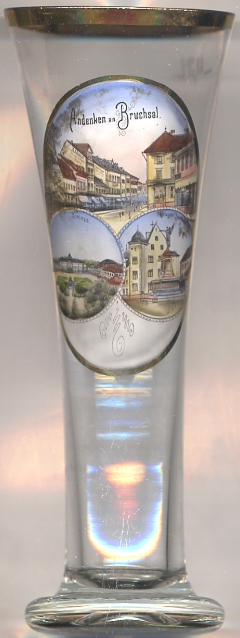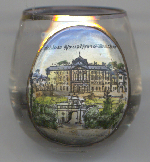

|
| DEUTSCHLAND | GERMANY |
| Bundesland: Baden-Württemberg | |
| Regierungsbezirk: Karlsruhe | |
| Landkreis: Karlsruhe |
Bruchsal is situated at an elevation of 114 m at the western end of the Kraichgau region, about 20 km northeast of Karlsruhe. The municipality has a population of about 42,400 (2012).
Excavations and artifacts provide evidence of a settlement on the Michelsberg (Untergrombach) as early as 4000 BC during the Neolithic. In the core of Bruchsal
the oldest settlement discovered was dated back to AD 640. It is located near the present Peterskirche. The first mention of Bruchsal in official documents occurred in 976.
Another document, issued here in Bruchsal in 996, a deed of donation issued by Emperor Otto III for the bishop of Freising, is the oldest known document mentioning
the name Ostarrichi, i.e. Austria.
German king Heinrichy II became ruler of Bruchsal in 1002 following the subjugation of his rival Herrmann of Swabia. In 1056 Heinrich III presented the settlement to the
bishop of Speyer as a gift. The city remained part the bishopric until the German Mediatisation in 1802. In 1248 Bruchsal was referred to as a city
for the first time. Bruchsal was almost completely destroyed during the Thirty Years' War in 1622, and again by French troops in 1676 and 1689.
In 1716, the bishop of Speyer moved the residence of his territory to Bruchsal. Following the mediatisation in 1802, Bruchsal became part of the margraviate (1803 Electorate,
1806 Grand Duchy) of Baden. In 1841 the Rhine Valley Railway was completed between Heidelberg, Bruchsal, and Karlsruhe.
In 1864 the district (Amt) Philippsburg was merged with the district (Oberamt) Bruchsal as part of the district (Kreis) Karlsruhe.
In 1936 parts of the Bretten district were merged with the Bruchsal district (1939 Landkreis Bruchsal).
On the afternoon of March 1, 1945, Bruchsal was bombed by the Allies. At the time of the attack, the war was essentially over, with the front line only 20 km from the city limits.
 Hence, the attack was unnecessary and inconsequential to the outcome of the war. In addition to the 1,000 lives that perished that day, the entire inner city and the Baroque
palace were destroyed. Starting from 1 April 1956 Bruchsal was awarded the Große Kreisstadt status, as its population had passed the 20,000 mark in 1955. Between 1971 and 1974
the local government reform incorporated 5 neighbouring communities into the city of Bruchsal, including the cities of Heidelsheim and Obergrombach. Under a further reform in 1973,
Bruchsal was incorporated into the district of Karlsruhe.
Hence, the attack was unnecessary and inconsequential to the outcome of the war. In addition to the 1,000 lives that perished that day, the entire inner city and the Baroque
palace were destroyed. Starting from 1 April 1956 Bruchsal was awarded the Große Kreisstadt status, as its population had passed the 20,000 mark in 1955. Between 1971 and 1974
the local government reform incorporated 5 neighbouring communities into the city of Bruchsal, including the cities of Heidelsheim and Obergrombach. Under a further reform in 1973,
Bruchsal was incorporated into the district of Karlsruhe.
[https://en.wikipedia.org/wiki/Bruchsal, https://de.wikipedia.org/wiki/Bruchsal, https://de.wikipedia.org/wiki/Geschichte_der_Stadt_Bruchsal]

 Bruchsal palace [left, no. 3952, and far left, no. 2902: bottom left] was built in the Baroque style of the mid-18th century, starting around 1720, and served as
the official residence of the bishops of Speyer. Its centre was a three-winged building that was based on the plans of Maximilian von Welsch. After the plans had been modified
several times, the central staircase was built by Balthasar Neumann, who had taken over and filled the role of chief engineer since 1731. It is generally regarded as one of the
most successful design solutions for a Baroque staircase. The palace complex includes numerous other buildings, among them Damian's Gate and the church of the court.
After the mediatisation of the territory of the bishopric in 1802, the palace became the home of Princess Amalie of Hesse-Darmstadt, widow of
Hereditary Prince Karl Ludwig of Baden. Amalie lived here until here death in 1832. She was widely known as the 'Mother-in-Law of Europe' as five of her six daughters married
European monarchs: Karoline married King Maximilian I Joseph of Bavaria, Luise married tsar Alexander I of Russia, Friederike married (but later divorced) King Gustav IV Adolf
of Sweden, Marie married Duke Friedrich Wilhelm of Braunschweig-Wolfenbüttel, and Wilhelmine married Grand Duke Ludwig II of Hesse. Her second son
Karl Ludwig Friedich followed his grandfather Karl Friedrich as Grand Duke Karl of Baden and married Stéphanie de Beauharnais, adopted daughter of Napoléon Bonaparte.
In the closing days of World War II the palace
was badly damaged by an air raid aimed at Bruchsal, and it burned out completely. The famous staircase largely survived (though
it was badly damaged), but the dome did not. After lengthy discussions about whether and how it should be done, the large central part of the building (corps de logis) was
reconstructed (well into the 1970s) as a museum, while the church wing design was changed to a modern design.
Bruchsal palace [left, no. 3952, and far left, no. 2902: bottom left] was built in the Baroque style of the mid-18th century, starting around 1720, and served as
the official residence of the bishops of Speyer. Its centre was a three-winged building that was based on the plans of Maximilian von Welsch. After the plans had been modified
several times, the central staircase was built by Balthasar Neumann, who had taken over and filled the role of chief engineer since 1731. It is generally regarded as one of the
most successful design solutions for a Baroque staircase. The palace complex includes numerous other buildings, among them Damian's Gate and the church of the court.
After the mediatisation of the territory of the bishopric in 1802, the palace became the home of Princess Amalie of Hesse-Darmstadt, widow of
Hereditary Prince Karl Ludwig of Baden. Amalie lived here until here death in 1832. She was widely known as the 'Mother-in-Law of Europe' as five of her six daughters married
European monarchs: Karoline married King Maximilian I Joseph of Bavaria, Luise married tsar Alexander I of Russia, Friederike married (but later divorced) King Gustav IV Adolf
of Sweden, Marie married Duke Friedrich Wilhelm of Braunschweig-Wolfenbüttel, and Wilhelmine married Grand Duke Ludwig II of Hesse. Her second son
Karl Ludwig Friedich followed his grandfather Karl Friedrich as Grand Duke Karl of Baden and married Stéphanie de Beauharnais, adopted daughter of Napoléon Bonaparte.
In the closing days of World War II the palace
was badly damaged by an air raid aimed at Bruchsal, and it burned out completely. The famous staircase largely survived (though
it was badly damaged), but the dome did not. After lengthy discussions about whether and how it should be done, the large central part of the building (corps de logis) was
reconstructed (well into the 1970s) as a museum, while the church wing design was changed to a modern design.
[https://en.wikipedia.org/wiki/Bruchsal, https://de.wikipedia.org/wiki/Amalie_von_Hessen-Darmstadt]
The  Hoheneggerhof [left, no. 2902: bottom right: background] was built in 1550–1554 as an administrative building for the bishopric.
The building received its popular name from an owner of the building at the end of the 16th century. The building was severely damaged by the air raid of 1 March 1945
and was finally torn down after the war.
Hoheneggerhof [left, no. 2902: bottom right: background] was built in 1550–1554 as an administrative building for the bishopric.
The building received its popular name from an owner of the building at the end of the 16th century. The building was severely damaged by the air raid of 1 March 1945
and was finally torn down after the war.
[http://www.bruchsal.de/servlet/PB/show/1400571/Endbericht-Hohenegger_Quartier.pdf, http://www.flickr.com/photos/infactoweb/4523549961/]
The  soldiers' monument [left, no. 2902: bottom right: foreground] was created in 1978 as a memorial to the Franco-Prussian war of 1870/1871.
The metal statue of "Victory", created by the art foundry Lenz of Nuremberg, was melted down in 1918.
soldiers' monument [left, no. 2902: bottom right: foreground] was created in 1978 as a memorial to the Franco-Prussian war of 1870/1871.
The metal statue of "Victory", created by the art foundry Lenz of Nuremberg, was melted down in 1918.
[https://de.wikipedia.org/wiki/Kunstgießerei_Lenz, http://ka.stadtwiki.net/Benutzer:Suggs/Schmierblatt]
![[scale]](lineal.jpg)